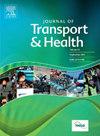Towards horizontal and vertical equity of sports facilities: An assessment of accessibility under multiple transportation modes
IF 3.3
3区 工程技术
Q2 PUBLIC, ENVIRONMENTAL & OCCUPATIONAL HEALTH
引用次数: 0
Abstract
Introduction
Sports facilities provision is a prioritized topic in public health. Equity has been a primary concern when the majority focused on spatial allocation and accessibility assessments with unsystematic equity analysis. Transportation is a critical element causing mobility constraints in megacities, where underlying inequities have been observed in accessibility under multiple transportation modes. This research provides insights into distributional injustice in high-density cities and contributes to promoting public health and mitigating social inequities.
Methods
This study measures horizontal and vertical equity based on the accessibility of sports facilities in Shanghai under multiple transportation modes using WebAPIs at different thresholds. For equity analyses, the Gini coefficient and bivariate spatial autocorrelation are used to assess spatial equity citywide and compare differences between social groups.
Results
The findings reveal: (1) an intensified central-periphery pattern, with 80 %∼90 % of high-accessibility areas concentrated in central districts; (2) horizontal inequity with an overall Gini coefficient above 0.6 and central districts mostly below 0.2, showing great regional disparities; (3) severe vertical inequity in disadvantaged areas where the underprivileged group suffers from a higher unequal situation than intermediate and privileged groups. Equity performs the worst at the 5-min threshold. Vertical inequity generally surpasses horizontal inequity.
Conclusions
Both horizontal and vertical inequity of sports facilities in Shanghai is adding pressure on public health. Through the continuous efforts of preferential policies for the underprivileged, enhanced public transport and community-level services, horizontal equity is expected to improve by 7.8 % by 2030.
体育设施横向与纵向公平性:多种交通方式下的可达性评价
体育设施的提供是公共卫生的一个优先课题。当大多数人关注空间分配和可达性评估时,公平性一直是主要关注的问题,而不是系统的公平性分析。在特大城市中,交通是造成流动性限制的一个关键因素,多种交通方式下的可达性存在潜在的不平等。这项研究提供了对高密度城市分配不公的见解,有助于促进公共卫生和减轻社会不平等。方法采用webapi在不同阈值下对上海市多种交通方式下的体育设施可达性进行横向和纵向公平性测度。在公平分析方面,利用基尼系数和双变量空间自相关来评估全市的空间公平,并比较社会群体之间的差异。结果:(1)高通达性区域呈中心—边缘强化格局,80% ~ 90%的高通达性区域集中在中心区;(2)横向不平等,总体基尼系数大于0.6,中心地区多小于0.2,区域差异较大;(3)弱势地区纵向不平等严重,弱势群体的不平等程度高于中间群体和特权群体。股票在5分钟阈值时表现最差。纵向不平等通常超过横向不平等。结论上海市体育设施的横向和纵向不平等都增加了公共卫生压力。通过对弱势群体的优惠政策、加强公共交通和社区服务的持续努力,预计到2030年,横向公平将提高7.8%。
本文章由计算机程序翻译,如有差异,请以英文原文为准。
求助全文
约1分钟内获得全文
求助全文

 求助内容:
求助内容: 应助结果提醒方式:
应助结果提醒方式:


